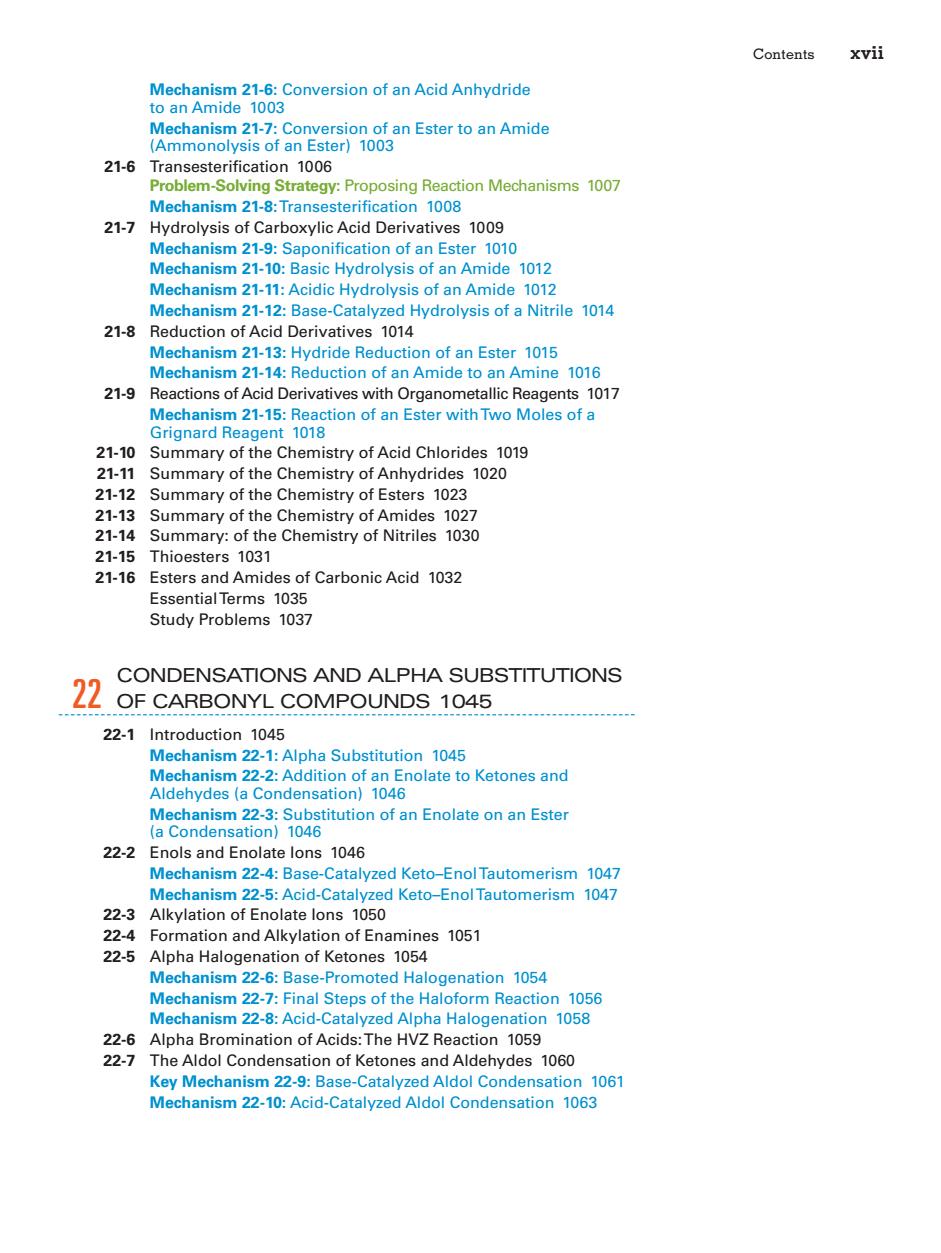
Contents xvii 0ehaesm21bgCoversionofanAcidAnhydide Mechar Mechanism 21-7:Conversion of an Ester to an Amide Ammonolysis of an Ester)1003 21-6 Transesterification 1006 Mech trategy:Prop ion Mechanisms 1007 21-7 cid Deriv 1009 n2110B2c on sm 21-11:Acidic H dr is of an Amide 1012 Mechanism 21-12:Base d Hydrolysis of a Nitrile 1014 21-8 Reduction of acid Derivatives 1014 Mechanism 2113.Hydride Reduction of an Ester 1015 Mechanism 21-14:Reduction of an Amide to an Amine 1016 21.9 Reactions of acid derivatives with organometallic Rea ents 1017 Mechanism 21-15:Reaction of an Ester with Two Moles of a Grignard Reagent 2110 1018 Summary of the Chemistry of Acid C rides nemistry o Anhydride 0g ummary or the ummary of the nem 21.15 T s1031 21-16 les of Carbonic Acid 1032 tial ter Study Proble 1s103 22 CONDENSATIONS AND ALPHA SUBSTITUTIONS OF CARBONYL COMPOUNDS 1045 22-1 Introduction 1045 Mechanism 22-1.Alnha Suhstitution 1045 Aldehydes (a C Mechanism 22-3:Subs titution of an Enolate on an Ester 22-2 Enols and Enolate lons 1046 Mechanis Base-Catalyzed Keto-noTautomerism1047 Mechanism 22-5 Acid-Catalyz zed Keto-EnolTautomerism 1047 22-3 Alkylation of Enolate lons 1050 22.4 Formation and Alkylation of Enamines 1051 22-5 Alpha Halogenation of Ketones 1054 Mechanism 22-6:Base-Promoted Halogenation 1054 Mechanism 22-7:Final Steps of the Haloform Reaction 1056 Mechanism 22-8:Acid-Catalyzed Alpha Halogenation 1058 22-6 Alpha Bromination of Acids:The HVZ Reaction 1059 22-7 The Aldol Condensation of Ketones and Aldehydes 1060 Key Mechanism 22-9:Base-Catalyzed Aldol Condensation 1061 Mechanism 22-10:Acid-Catalyzed Aldol Condensation 1063
Contents xvii Mechanism 21-6: Conversion of an Acid Anhydride to an Amide 1003 Mechanism 21-7: Conversion of an Ester to an Amide (Ammonolysis of an Ester) 1003 21-6 Transesterification 1006 Problem-Solving Strategy: Proposing Reaction Mechanisms 1007 Mechanism 21-8:Transesterification 1008 21-7 Hydrolysis of Carboxylic Acid Derivatives 1009 Mechanism 21-9: Saponification of an Ester 1010 Mechanism 21-10: Basic Hydrolysis of an Amide 1012 Mechanism 21-11: Acidic Hydrolysis of an Amide 1012 Mechanism 21-12: Base-Catalyzed Hydrolysis of a Nitrile 1014 21-8 Reduction of Acid Derivatives 1014 Mechanism 21-13: Hydride Reduction of an Ester 1015 Mechanism 21-14: Reduction of an Amide to an Amine 1016 21-9 Reactions of Acid Derivatives with Organometallic Reagents 1017 Mechanism 21-15: Reaction of an Ester with Two Moles of a Grignard Reagent 1018 21-10 Summary of the Chemistry of Acid Chlorides 1019 21-11 Summary of the Chemistry of Anhydrides 1020 21-12 Summary of the Chemistry of Esters 1023 21-13 Summary of the Chemistry of Amides 1027 21-14 Summary: of the Chemistry of Nitriles 1030 21-15 Thioesters 1031 21-16 Esters and Amides of Carbonic Acid 1032 Essential Terms 1035 Study Problems 1037 22 CONDENSATIONS AND ALPHA SUBSTITUTIONS OF CARBONYL COMPOUNDS 1045 22-1 Introduction 1045 Mechanism 22-1: Alpha Substitution 1045 Mechanism 22-2: Addition of an Enolate to Ketones and Aldehydes (a Condensation) 1046 Mechanism 22-3: Substitution of an Enolate on an Ester (a Condensation) 1046 22-2 Enols and Enolate Ions 1046 Mechanism 22-4: Base-Catalyzed Keto–Enol Tautomerism 1047 Mechanism 22-5: Acid-Catalyzed Keto–Enol Tautomerism 1047 22-3 Alkylation of Enolate Ions 1050 22-4 Formation and Alkylation of Enamines 1051 22-5 Alpha Halogenation of Ketones 1054 Mechanism 22-6: Base-Promoted Halogenation 1054 Mechanism 22-7: Final Steps of the Haloform Reaction 1056 Mechanism 22-8: Acid-Catalyzed Alpha Halogenation 1058 22-6 Alpha Bromination of Acids: The HVZ Reaction 1059 22-7 The Aldol Condensation of Ketones and Aldehydes 1060 Key Mechanism 22-9: Base-Catalyzed Aldol Condensation 1061 Mechanism 22-10: Acid-Catalyzed Aldol Condensation 1063
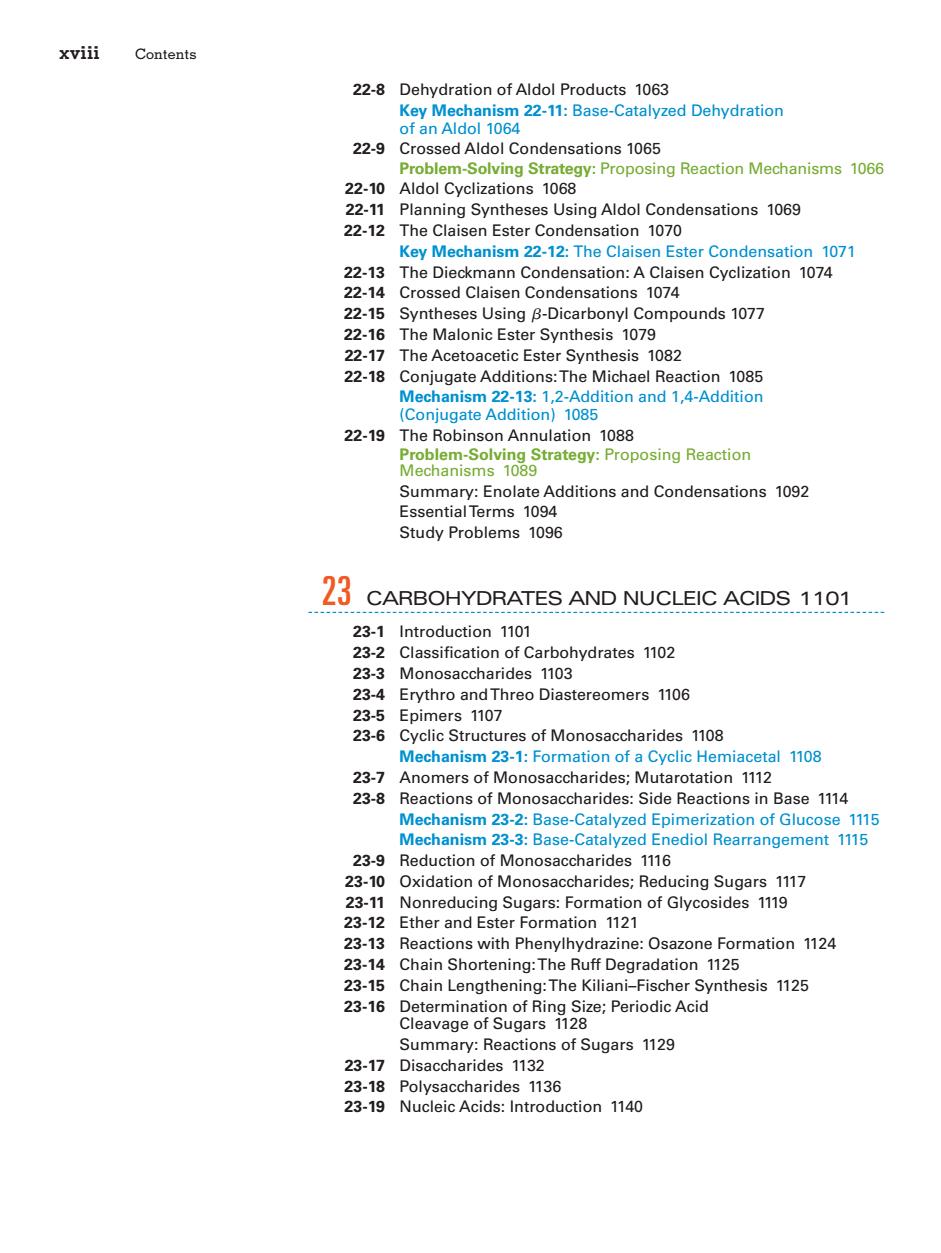
xviii Contents 22-8 Dehydration of Aldol Products 1063 Key Mechanism 22-11:Base-Catalyzed Dehydration of an Aldol 1064 22-9 Crossed Aldol Cor ndensations 1065 :Proposing Reaction Mechanisms1066 ations ing Aldol densations 1069 0> anis 1071 22-13 22.14 ensation:A 1074 22.15 Syntheses us ds1077 22-16 g B-Dicar The Malonic Est 1079 22.17 The Acetoacetic Ester Synthesis 10只2 22-18 Conjugate Additions:The Michael Reaction 1085 Mechanism 22-13:1,2-Addition and 1,4-Addition Conjugate Addition)1085 22-19 The Robinson Annulation 1088 sing Reaction Summary:Enolate Additions and Condensations 1092 EssentialTerms 1094 Study Problems 1096 23 CARBOHYDRATES AND NUCLEIC ACIDS 1101 23-1 Introduction 1101 23-2 Classification of Carbohydrates 1102 233 Monosaccharides 1103 23-4 Erythro and Threo Diastereomers 1106 23-5 Epimers 1107 23-6 Cyclic Structures of monosaccharides 1108 Mechanism 23-1:Formation of a Cyclic Hemiacetal 1108 23-7 Anomers of monosaccharides:Mutarotation 1112 23-8 Reactions of Monosaccharides:Side Reactions in Base 1114 Mechanism 23-2:Base-Catalyzed Epimerization of Glucose 1115 Mechanism 23-3:Base-Catalyzed Enediol Rearrangement 1115 Reduction of Monosaccharides 1116 Oxidation of Monosaccharides;Reducing Sugars 1117 therandEgeafomatonofGveosidein9 er Form 112 y ormation 1124 2315 0a0 Chain L engthening:The Synthesis 1125 23-16 Cleavage of Sugars 1128 Summary:Reactions of Sugars 1129 23.17 Disaccharides 1132 23-18 Polysaccharides 1136 23-19 Nucleic Acids:Introduction 1140
xviii Contents 22-8 Dehydration of Aldol Products 1063 Key Mechanism 22-11: Base-Catalyzed Dehydration of an Aldol 1064 22-9 Crossed Aldol Condensations 1065 Problem-Solving Strategy: Proposing Reaction Mechanisms 1066 22-10 Aldol Cyclizations 1068 22-11 Planning Syntheses Using Aldol Condensations 1069 22-12 The Claisen Ester Condensation 1070 Key Mechanism 22-12: The Claisen Ester Condensation 1071 22-13 The Dieckmann Condensation: A Claisen Cyclization 1074 22-14 Crossed Claisen Condensations 1074 22-15 Syntheses Using -Dicarbonyl Compounds 1077 22-16 The Malonic Ester Synthesis 1079 22-17 The Acetoacetic Ester Synthesis 1082 22-18 Conjugate Additions: The Michael Reaction 1085 Mechanism 22-13: 1,2-Addition and 1,4-Addition (Conjugate Addition) 1085 22-19 The Robinson Annulation 1088 Problem-Solving Strategy: Proposing Reaction Mechanisms 1089 Summary: Enolate Additions and Condensations 1092 Essential Terms 1094 Study Problems 1096 23 CARBOHYDRATES AND NUCLEIC ACIDS 1101 23-1 Introduction 1101 23-2 Classification of Carbohydrates 1102 23-3 Monosaccharides 1103 23-4 Erythro and Threo Diastereomers 1106 23-5 Epimers 1107 23-6 Cyclic Structures of Monosaccharides 1108 Mechanism 23-1: Formation of a Cyclic Hemiacetal 1108 23-7 Anomers of Monosaccharides; Mutarotation 1112 23-8 Reactions of Monosaccharides: Side Reactions in Base 1114 Mechanism 23-2: Base-Catalyzed Epimerization of Glucose 1115 Mechanism 23-3: Base-Catalyzed Enediol Rearrangement 1115 23-9 Reduction of Monosaccharides 1116 23-10 Oxidation of Monosaccharides; Reducing Sugars 1117 23-11 Nonreducing Sugars: Formation of Glycosides 1119 23-12 Ether and Ester Formation 1121 23-13 Reactions with Phenylhydrazine: Osazone Formation 1124 23-14 Chain Shortening: The Ruff Degradation 1125 23-15 Chain Lengthening: The Kiliani–Fischer Synthesis 1125 23-16 Determination of Ring Size; Periodic Acid Cleavage of Sugars 1128 Summary: Reactions of Sugars 1129 23-17 Disaccharides 1132 23-18 Polysaccharides 1136 23-19 Nucleic Acids: Introduction 1140 b
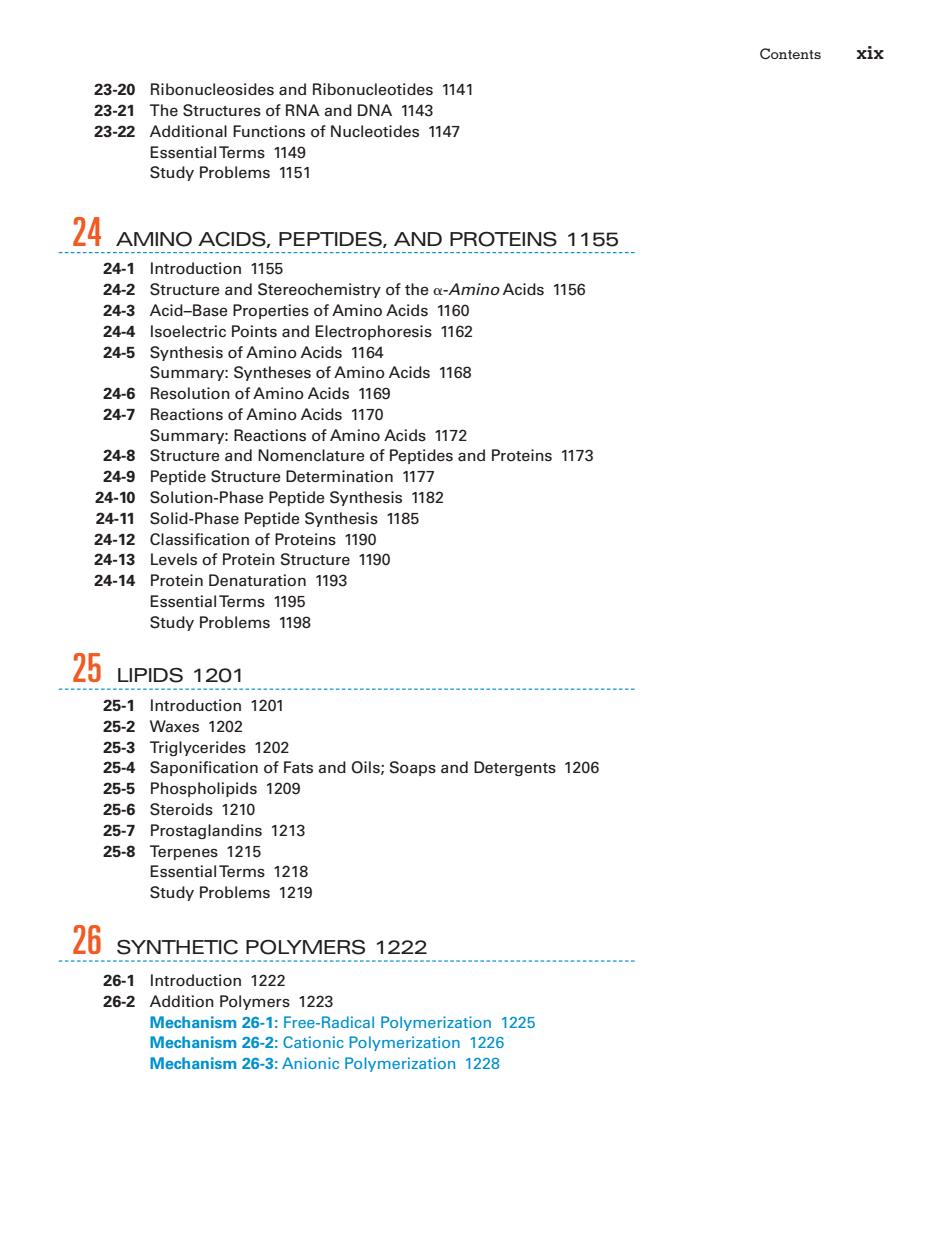
Contents xix Ribon nd Ribor 23-2 rof RNA cleotides 1141 ditio cleotides 1147 1149 rm1151 24 AMINO ACIDS.PEPTIDES,AND PROTEINS 1155 24-1 Introduction 1155 24-2 and St -Amino Acids 1156 24-3 Acid-Base Pro 2A4 lsoelectnicPo nts and Elect phoresis 1162 24- Synthesis of amino Acids 1164 Summary:Syntheses of Amino Acids 1168 24-6 Resolution of amino Acids 1169 24-7 Reactions of Amino Acids 1170 Summary:Reactions of Amino Acids 1172 24-8 Structure and Nomenclature of Peptides and Proteins 1173 24-9 Peptide Structure Determination 1177 24-10 Solution-Phase Peptide Synthesis 1182 2411 Solid-Phase Peptide Synthesis 1185 Classification of Proteins 1190 Levels of Protein Structure 1190 Protein Denat 1119 al Terms 1195 Study Problems 1198 25 LIPIDS 1201 257 25-2 s1202 25-5 Phospholipids 1209 25-6 Steroids 1210 25-7 Prostaglandins 1213 25-8 Terpenes 1215 EssentialTerms 1218 stud小Problems121g 26 SYNTHETIC POLYMERS.1222 26-1 Introduction 1222 26-2 Addition Polvmers 1223 Mechanism 26-1:Free-Radical Polymerization 1225 Mechanism 26-2:Cationic Polymerization 1226 Mechanism 26-3:Anionic Polymerization 1228
Contents xix 23-20 Ribonucleosides and Ribonucleotides 1141 23-21 The Structures of RNA and DNA 1143 23-22 Additional Functions of Nucleotides 1147 Essential Terms 1149 Study Problems 1151 24 AMINO ACIDS, PEPTIDES, AND PROTEINS 1155 24-1 Introduction 1155 24-2 Structure and Stereochemistry of the -Amino Acids 1156 24-3 Acid–Base Properties of Amino Acids 1160 24-4 Isoelectric Points and Electrophoresis 1162 24-5 Synthesis of Amino Acids 1164 Summary: Syntheses of Amino Acids 1168 24-6 Resolution of Amino Acids 1169 24-7 Reactions of Amino Acids 1170 Summary: Reactions of Amino Acids 1172 24-8 Structure and Nomenclature of Peptides and Proteins 1173 24-9 Peptide Structure Determination 1177 24-10 Solution-Phase Peptide Synthesis 1182 24-11 Solid-Phase Peptide Synthesis 1185 24-12 Classification of Proteins 1190 24-13 Levels of Protein Structure 1190 24-14 Protein Denaturation 1193 Essential Terms 1195 Study Problems 1198 25 LIPIDS 1201 25-1 Introduction 1201 25-2 Waxes 1202 25-3 Triglycerides 1202 25-4 Saponification of Fats and Oils; Soaps and Detergents 1206 25-5 Phospholipids 1209 25-6 Steroids 1210 25-7 Prostaglandins 1213 25-8 Terpenes 1215 Essential Terms 1218 Study Problems 1219 26 SYNTHETIC POLYMERS 1222 26-1 Introduction 1222 26-2 Addition Polymers 1223 Mechanism 26-1: Free-Radical Polymerization 1225 Mechanism 26-2: Cationic Polymerization 1226 Mechanism 26-3: Anionic Polymerization 1228�
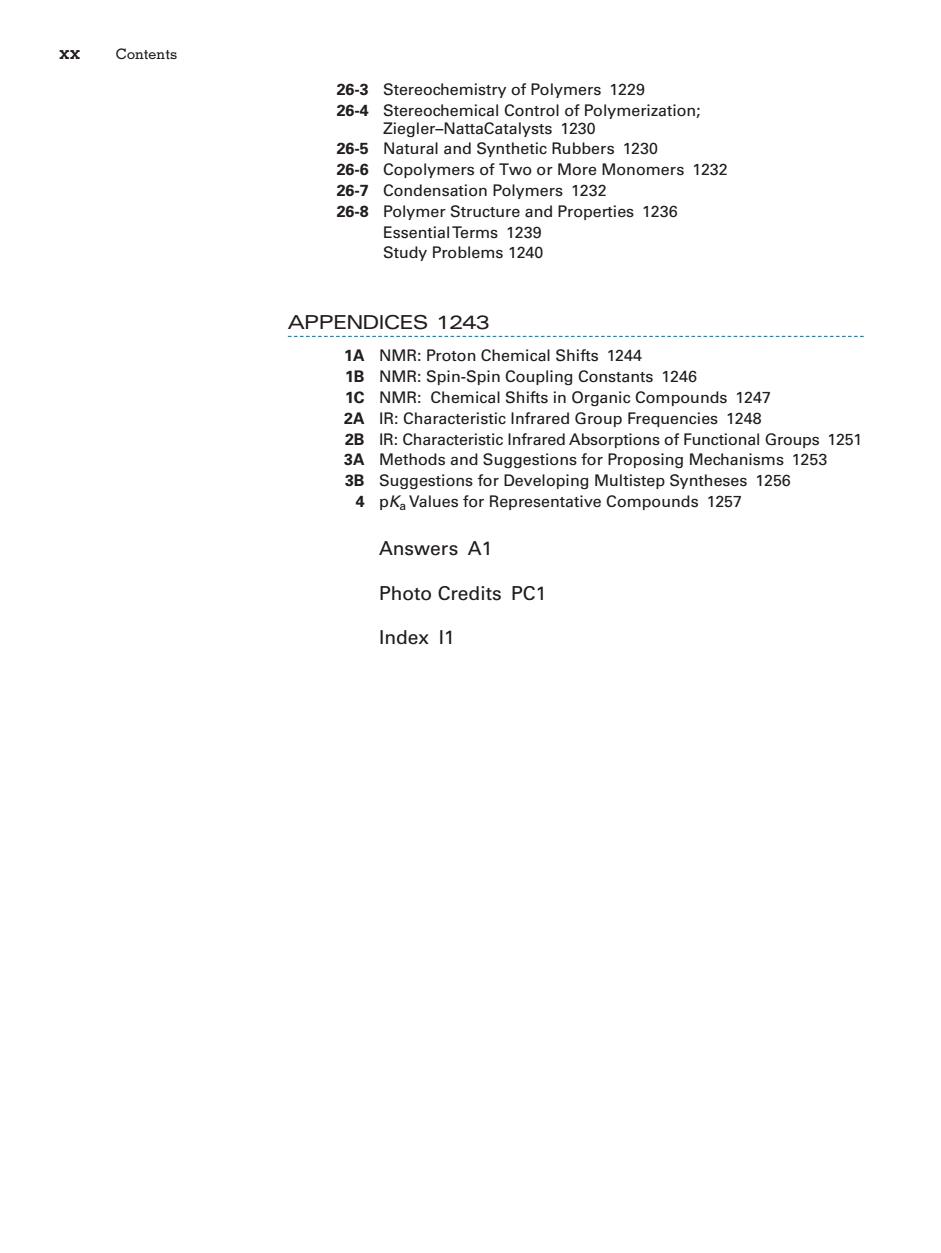
Xx Contents 26-3 Stereochemistry of Polymers 1229 26-4 Stereochemical Control of Polymerization Ziegler-NattaCatalysts 1230 26-5 Natural and Synthetic Rubbers 1230 26-6 Copolymers of Two or More Monomers 1232 26-7 Condensation Polymers 1232 26-8 Polymer Structure and Properties 1236 APPENDICES 1243 1A NMR:Proton Chemical Shifts 1244 1B NMR:Spin-Spin Coupling Consta nts 1246 1C NMR:Chemical Shifts Compounds 1247 2A IR:Characteristic Infrared Gre uencies 1248 2B IR:Characteristic Infrared Absorptions of Functional Groups 1251 3A Methods and Suggestions for Proposing Mechanisms 1253 3B Suggestions for Developing Multistep Syntheses 1256 4 pKa Values for Representative Compounds 1257 Answers A1 Photo Credits PC1 Index 11
xx Contents 26-3 Stereochemistry of Polymers 1229 26-4 Stereochemical Control of Polymerization; Ziegler–NattaCatalysts 1230 26-5 Natural and Synthetic Rubbers 1230 26-6 Copolymers of Two or More Monomers 1232 26-7 Condensation Polymers 1232 26-8 Polymer Structure and Properties 1236 Essential Terms 1239 Study Problems 1240 APPENDICES 1243 1A NMR: Proton Chemical Shifts 1244 1B NMR: Spin-Spin Coupling Constants 1246 1C NMR: Chemical Shifts in Organic Compounds 1247 2A IR: Characteristic Infrared Group Frequencies 1248 2B IR: Characteristic Infrared Absorptions of Functional Groups 1251 3A Methods and Suggestions for Proposing Mechanisms 1253 3B Suggestions for Developing Multistep Syntheses 1256 4 Values for Representative Compounds 1257 Answers A1 Photo Credits PC1 Index I1 pKa
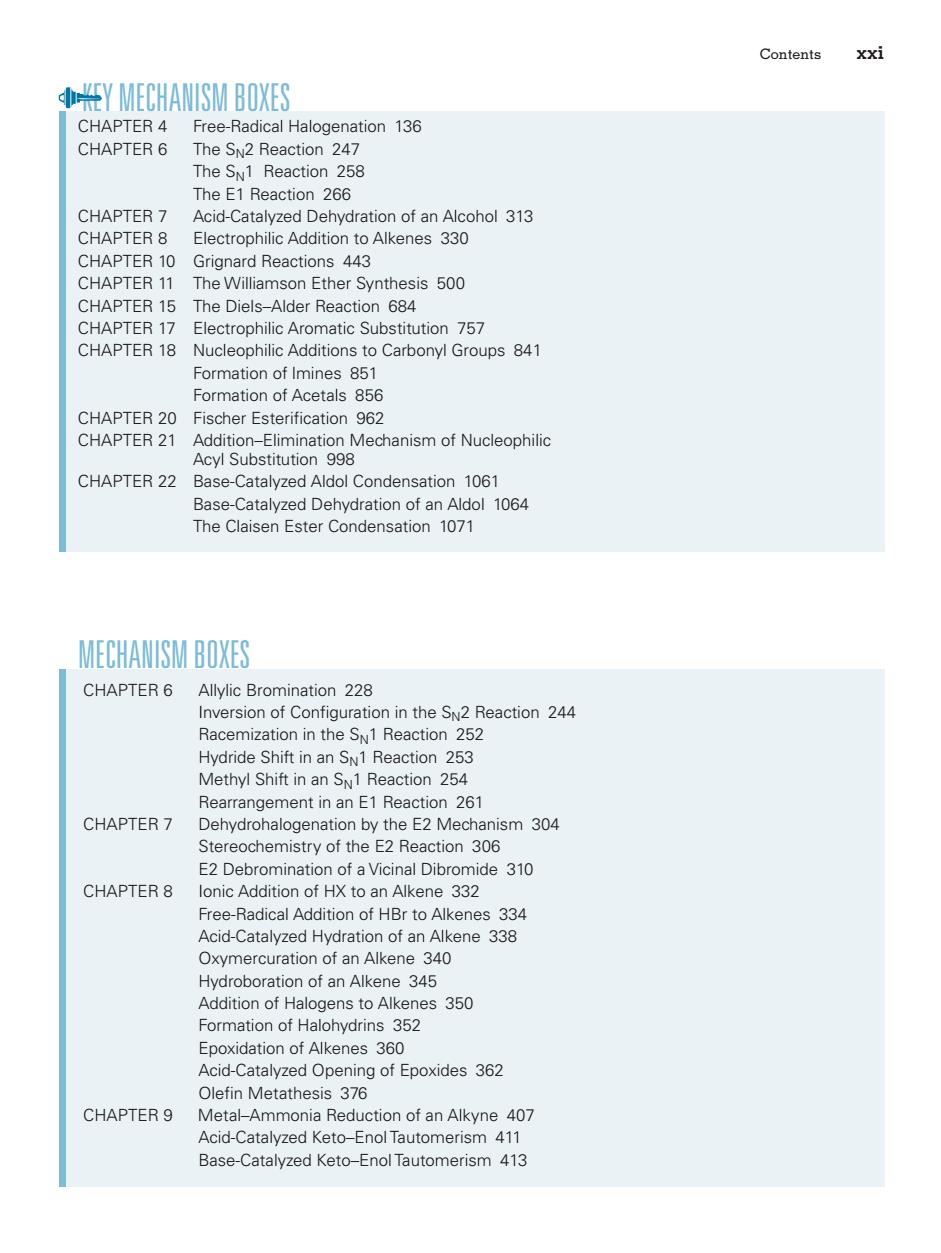
Contents xxi Y MECHANISM BOXES CHAPTER 4 Free-Radical Halogenation 136 CHAPTER 6 The s.2 Beaction 247 The S1 Reaction 258 The E1 Reaction 266 CHAPTER 7 ehydration of an Alcohol 313 CHAPTER 8 CHAPTER 10 CHAPTER 11 The Williamson Ether Synthesis 500 CHAPTER 15 The Diels-Alder Reaction 684 CHAPTER 17 Electrophilic Aromatic Substitution 757 CHAPTER 18 Nucleophilic Additions to Carbonyl Groups 841 Formation of Imines 851 Formation of acetals 856 CHAPTER 20 Fischer Esterification 962 CHAPTER 21 Mechanism of Nucleophilic CHAPTER 22 Base-Catalyzed Aldol Condensation 1061 Base-Catalyz Aldol 1064 MECHANISM BOXES CHAPTER 6 Allylic Bromination 228 Inversion of Configuration in the SN2 Reaction 244 Racemization in the sN1 Reaction 252 Hydride Shift in an S1 Reaction 253 Methyl Shift in an SN1 Reaction 254 CHAPTER 7 chanism 304 Stereochemistry of the E2 Reaction 306 E2 Debromination of a Vicinal Dibromide 310 CHAPTER 8 lonic Addition of HX to an Alkene 332 Free-Radical Addition of HBr to Alkenes 334 Acid-Catalyzed Hydration of an Alkene 338 Oxvmercuration of an Alkene 340 of Hal Format on of Hagens s350 Epo idation of Alkenes 360 Acid-Catalyzed Opening of Epoxides 362 Olefin Metathesis 376 CHAPTER 9 Metal-Ammonia Reduction of an Alkyne 407 Acid-Catalyzed Keto-Enol Tautomerism 411 Base-Catalyzed Keto-Enol Tautomerism 413
Contents xxi MECHANISM BOXES CHAPTER 6 Allylic Bromination 228 Inversion of Configuration in the SN2 Reaction 244 Racemization in the SN1 Reaction 252 Hydride Shift in an SN1 Reaction 253 Methyl Shift in an SN1 Reaction 254 Rearrangement in an E1 Reaction 261 CHAPTER 7 Dehydrohalogenation by the E2 Mechanism 304 Stereochemistry of the E2 Reaction 306 E2 Debromination of a Vicinal Dibromide 310 CHAPTER 8 Ionic Addition of HX to an Alkene 332 Free-Radical Addition of HBr to Alkenes 334 Acid-Catalyzed Hydration of an Alkene 338 Oxymercuration of an Alkene 340 Hydroboration of an Alkene 345 Addition of Halogens to Alkenes 350 Formation of Halohydrins 352 Epoxidation of Alkenes 360 Acid-Catalyzed Opening of Epoxides 362 Olefin Metathesis 376 CHAPTER 9 Metal–Ammonia Reduction of an Alkyne 407 Acid-Catalyzed Keto–Enol Tautomerism 411 Base-Catalyzed Keto–Enol Tautomerism 413 CHAPTER 4 Free-Radical Halogenation 136 CHAPTER 6 The SN2 Reaction 247 The SN1 Reaction 258 The E1 Reaction 266 CHAPTER 7 Acid-Catalyzed Dehydration of an Alcohol 313 CHAPTER 8 Electrophilic Addition to Alkenes 330 CHAPTER 10 Grignard Reactions 443 CHAPTER 11 The Williamson Ether Synthesis 500 CHAPTER 15 The Diels–Alder Reaction 684 CHAPTER 17 Electrophilic Aromatic Substitution 757 CHAPTER 18 Nucleophilic Additions to Carbonyl Groups 841 Formation of lmines 851 Formation of Acetals 856 CHAPTER 20 Fischer Esterification 962 CHAPTER 21 Addition–Elimination Mechanism of Nucleophilic Acyl Substitution 998 CHAPTER 22 Base-Catalyzed Aldol Condensation 1061 Base-Catalyzed Dehydration of an Aldol 1064 The Claisen Ester Condensation 1071 KEY MECHANISM BOXES